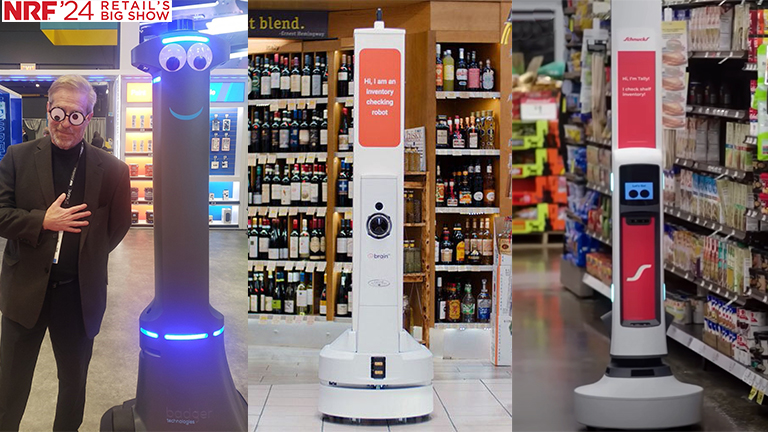
Images courtesy: Badger Technologies, Brain Corp., Simbe Robotics, Inc.
NRF 2024: Are Inventory Robots Getting Friendlier?
I’ve made fun of retail robots plenty of times in the past, so it’s only right to share an updated perspective, informed by several encounters at the recent NRF 2024: Retail’s Big Show expo in New York.
Three vendors whose robots are now hard at work gathering inventory data in hundreds of food retail locations kindly provided progress updates. The conversations included William (BJ) Santiago, CEO of Badger Technologies, Brad Bogolea, CEO & founder of Simbe Robotics, Inc., and David Pinn, CEO of Brain Corp. All were forthcoming about their expanding retail deployments.
I am now persuaded that a friendly moment may be at hand for these aisle-roving towers. The latest generation blends automation and computer vision, with a whiff of AI woven in. A quick status update:
- Badger Technologies’ autonomous robots were first introduced at Stop & Shop (Ahold Delhaize USA) supermarkets in January 2019, where the retailer has cultivated a googly-eyed persona, “Marty,” intended to make the units appear friendlier to shoppers and children. That deployment has now expanded to more than 300 of the East Coast retailer’s locations. The latest upgraded devices not only flag out-of-stocks but also detect misplaced items and spot potential floor hazards and spills.
- Brain Corp. says its inventory scanning robots captured over 7.9 billion shelf images in 2023. The company, which operates 30,000 floor-cleaning and inventory robots in schools, airports, hospitals, and retailers like Walmart and Sam’s Club, introduced its latest inventory scanning towers in collaboration with Dane Technologies. The units run on an update of the BrainOS® robotics platform for in-store inventory visibility, backed by an analytics and data management solution. Sam’s Club began using Brain Corp. towers in 2022, and they presently operate in 600 locations chain-wide.
- Simbe Robotics, Inc. continues to refine its Store Intelligence™ solution across a growing store portfolio. Missouri-based Schnucks Markets has been its most engaged retail customer, dubbing its devices, “Tally.” Each tower is capable of scanning 30,000 products per hour, which adds up to roughly two hours to scan a supermarket. At NRF 2024, the company announced an update of its platform for large-format retail environments, now deployed across 237 BJ’s Wholesale Club locations.
It’s not at all a coincidence that “inventory accuracy” was oft-invoked on the NRF exhibit floor as a key enabler of improved retail performance. A number of other vendors offered sensing solutions that rely on hand-held devices, fixed cameras, moving cameras, and RFID tags to count items in the store environment and confirm merchandising compliance.
I would add “inventory recency” to the equation, too, since stock-on-hand can change with stunning speed in the course of the selling day. The latest generation of inventory towers takes advantage of faster image processing and communication speeds, as well as AI tools that rapidly analyze frequently collected data and provide alerts and recommendations.
It is worth noting that all three of these vendors and their retail partners have taken steps to refine the design of their devices to make them appear friendlier. Sleeker, less-imposing form factors along with those googly eyes and simple signage that explains their purpose are clearly intended to make shoppers feel comfortable co-navigating the shelves.
No longer a sci-fi story, retail inventory robots are becoming familiar and, dare I say, friendly.
Discussion Questions
Are aisle-roving inventory robots finally coming of age?
Should retailers remain wary about allowing autonomous devices to roam the aisles? Or does the value of accurate and timely inventory information justify them?
What benefits or perils may result from the accumulation of large inventory data sets using these devices?


As tools for counting inventory levels, ensuring display compliance, and identifying gaps I think robots have their place. But, as I have said many times before, they are not a complete replacement for humans. The point of having human staff walk the aisles in grocery stores is as much a customer service function as anything else: it creates a visible presence that reassures customers and provides someone to interact with should help be needed. So yes, robots might be becoming more useful in grocery but their rise does not spell the end of human associates.
There is no question that inventory levels are vital for sales. If robots can do better than humans (I believe they can.), then they should. The use of robots will really be valuable when the inventory robot advises the shelf-stocking robot what to do.
Best to ask customers first what they think of these roaming the aisles before adding. My own polls of independent grocery operators suggest customers don’t want them visible on the floor as part of the shopping experience. They feel both intrusive and in the way, especially down narrow aisles.
Operators could alternatively get inventory information with floor robots by only using them after store closing, overnight. Or consider shelf camera systems.
There’s no doubt inventory robots can do routine tasks better than their human counterparts, but I’ve always preferred a more holistic software + shelf or product-oriented approach to inventory counts. Unless there is no movement at all (adding products to shelf or sales), there is a greater chance of error with roving counters since stock levels are fluid and constantly in motion. As @NeilSaunders mentioned, part of the value of human staff in aisles was for customer service. Is friendliness in inventory robots something we need? Wouldn’t we want to have better frictionless stock accuracy and friendlier sales associates?